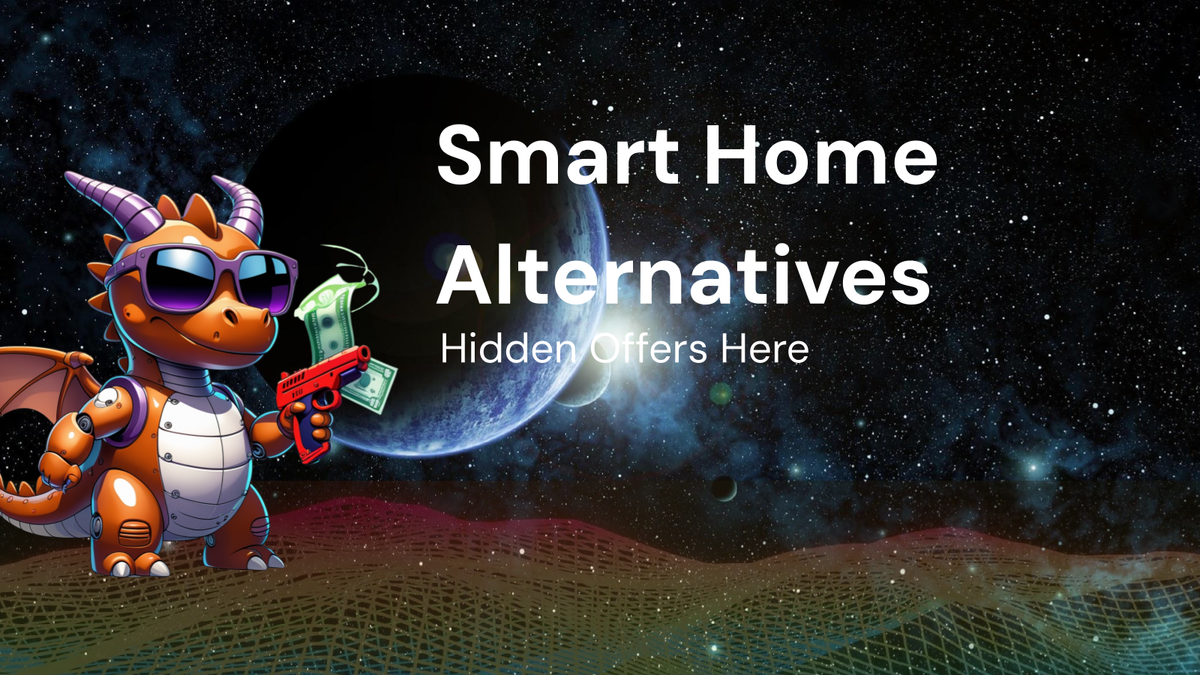Hidden Offers in Smart Home Alternatives: A Review

Hidden Offers in Smart Home Alternatives: A Review
The smart home market is booming. From voice-activated assistants controlling your lights to refrigerators that order groceries, the allure of a connected, automated living space is undeniable. However, the established players like Amazon, Google, and Apple, while dominating the headlines, aren't the only contenders in the smart home arena. A vibrant ecosystem of alternative platforms, devices, and solutions exists, often offering unique advantages and hidden offers that are easily overlooked.
This review delves into the world of smart home alternatives, exploring their strengths, weaknesses, and the hidden benefits they offer compared to the mainstream options. We'll examine factors like privacy, security, interoperability, customization, and cost-effectiveness, uncovering why choosing a less conventional path might be the smarter move for your specific needs.
Why Consider Smart Home Alternatives?
Before diving into specific alternatives, let's consider why you might want to deviate from the well-trodden path dominated by tech giants:
- Privacy Concerns: The data collection practices of major smart home providers are a growing concern for many users. Alternatives often prioritize user privacy, offering more control over data storage and usage.
- Vendor Lock-in: Opting for a single ecosystem like Amazon's Alexa or Google's Assistant can limit your choices and force you to purchase only compatible devices. Alternatives frequently promote open standards and interoperability.
- Limited Customization: While mainstream platforms offer a degree of customization, alternatives often provide more granular control over device settings, automation rules, and data analysis.
- Cost: The cost of entry into a smart home ecosystem can be significant, especially when considering subscriptions, proprietary devices, and professional installation. Alternatives may offer more affordable solutions, particularly for DIY enthusiasts.
- Innovation and Niche Functionality: Smaller companies are often more agile and willing to experiment with innovative features and cater to specific niche needs that mainstream platforms may ignore.
- Support for Open Source: Many alternatives are built on open-source platforms, allowing for community development, transparency, and the ability to modify the software to your liking.
Exploring Smart Home Alternative Categories:
We can broadly categorize smart home alternatives into the following:
- Open-Source Home Automation Platforms:
- Privacy-Focused Hardware and Software:
- Niche Smart Home Devices:
- DIY and Custom Solutions:
Let's examine each category in detail.
1. Open-Source Home Automation Platforms:
These platforms offer a high degree of control, customization, and privacy, but require technical expertise to set up and maintain.
- Home Assistant: Home Assistant is arguably the most popular open-source home automation platform. It boasts a vast community, extensive documentation, and integrations with thousands of devices and services. Key advantages include:
- Privacy-First Approach: Data is stored locally, giving you complete control over your information.
- Extensive Device Support: Home Assistant supports a wide range of devices, regardless of manufacturer or protocol.
- Highly Customizable: You can create complex automations, dashboards, and user interfaces tailored to your needs.
- Active Community: A large and active community provides support, develops integrations, and contributes to the platform's ongoing development.
- Challenges: Requires technical proficiency to install, configure, and maintain. The learning curve can be steep for beginners.
- OpenHAB: OpenHAB is another powerful open-source platform with a focus on flexibility and interoperability. It supports a variety of hardware and protocols, allowing you to integrate devices from different manufacturers seamlessly. Key advantages include:
- Device-Agnostic: OpenHAB works with virtually any device that supports a standard protocol.
- Rule Engine: A robust rule engine allows for complex automation scenarios.
- Web-Based Interface: A user-friendly web interface simplifies configuration and control.
- Challenges: Similar to Home Assistant, OpenHAB requires technical knowledge and a willingness to troubleshoot.
- Node-RED: While not strictly a dedicated home automation platform, Node-RED is a visual programming tool that can be used to create complex home automation flows. It offers a drag-and-drop interface for connecting devices, services, and APIs. Key advantages include:
- Visual Programming: Node-RED's visual interface makes it easy to create complex automations without writing code.
- Extensive Integration Capabilities: It can connect to virtually any device or service with an API.
- Lightweight and Flexible: Node-RED can be deployed on a variety of platforms, from Raspberry Pi to cloud servers.
- Challenges: Requires some programming knowledge to fully leverage its capabilities.
Hidden Offers of Open-Source Platforms:
- No Subscription Fees: Unlike many mainstream platforms, open-source solutions don't require subscription fees for basic functionality.
- Long-Term Viability: Since the code is open source, the platform will continue to exist even if the original developers abandon it.
- Community-Driven Development: New features and integrations are constantly being added by the community, ensuring the platform remains up-to-date.
- Complete Control: You have complete control over your data and how it's used.
- Learning and Personalization: The process of setting up and customizing these platforms is an enriching learning experience.
2. Privacy-Focused Hardware and Software:
These alternatives prioritize user privacy and data security, offering features like local data storage, end-to-end encryption, and minimal data collection.
- Mycroft AI: Mycroft AI is an open-source voice assistant that prioritizes privacy and customization. It runs on a variety of devices and allows you to control your smart home using voice commands. Key advantages include:
- Open Source: Mycroft's code is open source, allowing you to review and modify it.
- Privacy-Focused: Mycroft doesn't track your conversations or collect personal data without your consent.
- Customizable: You can customize Mycroft's voice, skills, and functionality.
- Challenges: Mycroft is still under development and may not have the same level of polish as mainstream voice assistants.
- Jottacloud: While not strictly a smart home platform, Jottacloud is a privacy-focused cloud storage provider that can be used to store data from your smart home devices. It offers end-to-end encryption and stores data in Norway, which has strict privacy laws. Key advantages include:
- End-to-End Encryption: Your data is encrypted before it leaves your device and remains encrypted in the cloud.
- Data Residency: Data is stored in Norway, ensuring compliance with European privacy regulations.
- Competitive Pricing: Jottacloud offers competitive pricing compared to other cloud storage providers.
- Challenges: Jottacloud is primarily a cloud storage provider and doesn't offer the same level of integration with smart home devices as dedicated platforms.
- ProtonMail/ProtonVPN: ProtonMail and ProtonVPN are privacy-focused email and VPN services that can be used to enhance the security of your smart home network. Key advantages include:
- End-to-End Encryption: ProtonMail encrypts your emails, preventing third parties from reading them.
- VPN Protection: ProtonVPN encrypts your internet traffic, protecting your privacy and security.
- Swiss Privacy Laws: ProtonMail and ProtonVPN are based in Switzerland, which has strong privacy laws.
- Challenges: These are security tools, not direct smart home platforms, but essential for protecting your network.
Hidden Offers of Privacy-Focused Alternatives:
- Peace of Mind: Knowing that your data is protected can provide peace of mind.
- Reduced Risk of Data Breaches: End-to-end encryption and other security measures can reduce the risk of data breaches.
- Support for Privacy-Focused Companies: Choosing privacy-focused alternatives supports companies that prioritize user privacy.
- Increased Control Over Your Data: You have more control over your data and how it's used.
3. Niche Smart Home Devices:
These devices cater to specific needs or offer unique features that are not available in mainstream products.
- Aqara: Aqara offers a range of Zigbee-based smart home devices that are affordable and compatible with Apple HomeKit, Amazon Alexa, and Google Assistant. Key advantages include:
- Affordable Pricing: Aqara devices are generally more affordable than those from other manufacturers.
- HomeKit Compatibility: Aqara devices work seamlessly with Apple HomeKit, allowing you to control them using Siri.
- Zigbee Protocol: Aqara uses the Zigbee protocol, which is more reliable and energy-efficient than Wi-Fi.
- Challenges: Requires an Aqara hub to connect to your network.
- Shelly: Shelly offers a range of Wi-Fi-enabled smart home devices that are designed for DIY enthusiasts. They can be easily integrated into existing electrical systems and offer a high degree of customization. Key advantages include:
- DIY Friendly: Shelly devices are designed for easy installation and configuration.
- Open API: Shelly offers an open API, allowing you to integrate them with other systems.
- Local Control: Shelly devices can be controlled locally, even without an internet connection.
- Challenges: Requires some electrical knowledge to install safely.
- Wyze: Wyze offers a range of affordable smart home devices, including cameras, lights, and sensors. While they have had some past security concerns, they remain popular due to their low cost and ease of use. Key advantages include:
- Low Cost: Wyze devices are among the most affordable on the market.
- Easy to Use: Wyze devices are easy to set up and use.
- Wide Range of Products: Wyze offers a wide range of smart home devices.
- Challenges: Past security concerns should be considered.
Hidden Offers of Niche Smart Home Devices:
- Specific Functionality: They often provide features tailored to specific needs (e.g., pet monitoring, elderly care).
- Affordability: They can be significantly cheaper than mainstream products.
- Flexibility: They often offer more flexibility in terms of integration and customization.
- Community Support: Many niche brands have dedicated communities that provide support and share tips.
4. DIY and Custom Solutions:
These solutions involve building your own smart home devices or integrating existing devices in unique ways.
- Raspberry Pi-Based Projects: The Raspberry Pi is a versatile single-board computer that can be used to create a wide range of smart home devices, from security cameras to home automation controllers. Key advantages include:
- Flexibility: You can customize the Raspberry Pi to meet your specific needs.
- Cost-Effective: The Raspberry Pi is relatively inexpensive.
- Learning Opportunity: Building your own smart home devices is a great way to learn about electronics and programming.
- Challenges: Requires technical expertise and a willingness to troubleshoot.
- Arduino-Based Projects: The Arduino is another popular platform for building DIY smart home devices. It's particularly well-suited for projects that involve interacting with the physical world. Key advantages include:
- Easy to Use: The Arduino is relatively easy to learn and use.
- Wide Range of Sensors and Actuators: A wide range of sensors and actuators are available for the Arduino.
- Low Power Consumption: The Arduino is very energy-efficient.
- Challenges: Requires some electronics knowledge.
- IFTTT (If This Then That): IFTTT is a web-based service that allows you to connect different apps and devices to create automations. While not a DIY solution in itself, it enables you to integrate devices from different manufacturers and create custom workflows. Key advantages include:
- Easy to Use: IFTTT is easy to set up and use.
- Wide Range of Integrations: IFTTT supports a wide range of apps and devices.
- Customizable: You can create custom automations tailored to your needs.
- Challenges: Relies on cloud services, which may raise privacy concerns.
Hidden Offers of DIY and Custom Solutions:
- Complete Control: You have complete control over your devices and how they're used.
- Unmatched Customization: You can create devices that meet your specific needs.
- Cost Savings: Building your own devices can be cheaper than buying commercial products.
- Personal Satisfaction: Building your own smart home devices can be a rewarding experience.
- Deeper Understanding of Technology: You'll gain a deeper understanding of how smart home technology works.
Choosing the Right Alternative for You:
The best smart home alternative for you depends on your specific needs, technical skills, and budget. Consider the following factors:
- Privacy Concerns: If privacy is a top priority, choose a platform that offers local data storage, end-to-end encryption, and minimal data collection.
- Technical Skills: If you're comfortable with technology, open-source platforms and DIY solutions may be a good fit. If you're less technical, look for user-friendly alternatives.
- Budget: Consider the upfront cost of devices and any ongoing subscription fees.
- Interoperability: Choose a platform that supports the devices you want to use.
- Customization: If you want to customize your smart home experience, choose a platform that offers a high degree of flexibility.
- Specific Needs: Consider any specific needs you have, such as pet monitoring or elderly care.
Conclusion:
The world of smart home alternatives is vast and diverse. While mainstream platforms offer convenience and ease of use, alternatives often provide greater privacy, customization, and affordability. By carefully considering your needs and exploring the options available, you can create a smart home that is tailored to your unique requirements and values. Don't be afraid to venture beyond the familiar names – you might be surprised by the hidden offers you discover. The future of smart homes lies not just in automation, but in empowering users to take control of their technology and data. By embracing alternatives, we can build smarter, more private, and more personalized living spaces. Remember to research thoroughly, consider community forums, and prioritize your own comfort level with technology when making your decisions. Good luck on your smart home journey!




